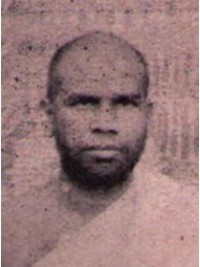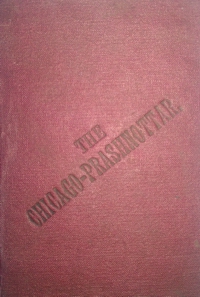98. Question:
What are the biographies and qualities of the Tirthankaras?Answer:If you want to read the biographies of the twenty four Jaina Tirthankaras in the historical form, please read the Trishashti Shalākā Purush Charitra by Hemachandra Suri. I give you a brief account of the life of the blessed Lord Mahavira, the last Tirthankara.
In the Videhdesh (ancient Mithila country) in Ksatriya Kundagrāma, there was a Raja named Siddhārtha, in the Sūrya-Vansha or Jnātavansha.He had a queen Trishlā, who gave birth to a child on Tuesday, Chaitra Sudi 13th at night in the 1st part of Uttrā Phālguni Nakchhatra, 542 years before Vikram Samvat. (i.e. about 600 B.C.) The parents gave him the birth name of Vardhmāna. When he attained maturity his parents married him with Yashodhā, the daughter of Sidharthā's feudatory Samarvir. When he became 28 years of age, his parents died. After that he remained in the family for 2 years at the request of his elder brother i.e. he remained in the house till he was aged 30 years and had one daughter named Priayadarshanā. After that he took initiation in the sādhu life, with the permission of his elder brother Nandivardhan. For one year he kept a piece of cloth placed on his shoulder by Indra. Subsequently he went about without clothes for the whole life. Although troubles befell him, he did not swerve from his true vow. Thereupon the devtās (good spirits) named him Mahavira. After his initiation, he renounced to commit or make others commit injury to living beings, he gave up speaking falsehood, theft, sexual intercourse, etc. He not only gave up all these sins himself but also prohibited others from doing them. He possessed threefold knowledge from his birth. Just at the time of initiation he obtained the 4th knowledge viz. manparyāy. The blessed Lord Mahavira practised great austerities for 12 1/2 years. It is fully described in Avashyak Sūtra and Kalpa Sūtra etc. what different troubles befell him for 12 1/2 years and at what different places and how he calmly and quietly bore all of them. What by means of the practice of austerities for 12 1/2 years and full meditation of virtue he completely destroyed his four ghati karmas (those which obstruct the good qualities of soul), then in the last pahār (a period of three hours) on Vaisākh Sudi 10th he attained Keval Jnāna (perfect knowledge) on the bank of the Rijuvālukā river in the village of Jram-bhika. He having left the aforesaid place arrived at Madhya-Pāpā Nagri. At that place there were eleven well-known Brahmans headed by Indrabhuti - Gautam - all learned in fourteen sciences. He removed all the doubts entertained by them in accordance with the Veda Srutis and by logical reasons and made the above mentioned eleven personages and their 4400 students as his disciples by performing their diksha ceremony. Out of them those (eleven) i.e. Gautam and others were given the title of Gandhara. They compiled the teachings of the Bhagvant in the books such as Achārānga etc.. He also gave diksha to Chandnā, the virgin daughter of king Dadhivāhan of Champa, who made 36000 disciples.
After the attainment of pure knowledge (Keval jnāna) he visited countries on the eastern side. In the life time of Lord Mahavira there were not more than 14000 sadhus, 46000 sadhwis, 159,000 srāvaks and 3,18000 srāvikās. The lectures of Lord Mahavira made several chiefs His votaries. They are as follows:
(I) Raja Srenika alias Bhambhasāra, King of Rajagrihi. (II) Ashoka Chandra alias Kunik king of Champā, son of Bhambha sāra. In the Buddhistic books he is named as Ajātshatra.
(III) Raja Chetaka, king of Vaishāli nagri.
(XXI) A group of 18 Rajas of Kashi and Kaushal.
(XXII) Vijaya king of Pulāspur.
(XXIII) Sveta king of Amalkalpā Nagri.
(XXIV) Raja Udāyan of Vitbhai-patan in Sindh.
(XXV) Raja Udayanvatsa of Kaushambhi.
(XXVI) Raja Nandi-Vardhan of Ksatriya kundagram.
(XXVII) Raja Chandra Pradyota of Ujjain.
(XXVIII)
Raja Shāl of Prishta Champa.
(XXIX)
Raja Prasanna Chandra of Potanpur.
(XXX)
Raja Adin Shatru of Hasti Shirsha nagar.
(XXXI)
Raja Dhanavah of Rishabhpur.
(XXXII)
Raja Vir Krishnamitra of Virpur nagar.
(XXXIII)
Raja Vasavdatta of Vijaipur.
(XXXIV)
Raja Pratihat of Saugandhik.
(XXXV)
Priya Chandra, king of Kanakpur.
(XXXVI)
Raja Bal of Mahapur.
(XXXVII)
Raja Arjun of Sughosh nagar.
(XXXVIII)
Raja Datta of Champā.
(XXXIX)
Raja Mitra Nandi of Saketpur.
(XL)
Raja Dasharn Bhadra of Dasharnpur,
and many other Rajas were the followers of Lord Mahāvira. The names of all these are found in the works known as Angas and Upangas. He lived 42 years after his initiation dikshā. Out of this period he passed first 12 Chaturmāsas (period of 4 months of the rainy season i.e. Shavan, Bhadrapad Ashwin and Kartiq) as chhadamast (passing saint's life before kevalagnāna) and the subsequent 30 Chaturmāsas as Kevali as given below:
The first 12 rainy seasons
1. Asthi-grāma, 2. Rājagrihi, 3. Champā. 4. Prishta Champā, 5. Bhadrikā nagri, 6. Bhadrika, 7. Alambhiyā, 8. Rājgrihi, 9. Anāryadesh, 10. Sāvathi, 11. Vishālā, 12. Champā.
As Kevali He passed 12 rainy seasons in Rajgrihi, 11 in Vishala, 6 in Mithila and 1 in Pāvāpuri. Out of 42 years, for 30 years Lord Mahavira taught dharma to all the 4 classes and spread dharma. He had his last rainy season at Pāvāpuri in the sabhā of the old office of the king Hstipalā. He attained nirvana i.e. Mukti-pad, Siddhapad, Parmeshwār-pād (liberation) on Kartik vadi l5th at night.
According to the test just described the avatārs believed in by other religionists, were not free from 18 faults. It was only Arhat who was free from 18 dushans (faults). The God believed in by other religionists is according to their own allegations proved to be ignorant, incompetent, having liking and disliking, merciless, prejudiced, imprudent etc.. Consequently there is no God besides Arhat and Siddha. This is the main doctrine of Jainas.
The Siddha does not concern himself with the affairs of the world. The blessed Arhat teaches only Dharma. He does not do any worldly work except teaching dharma. This proves that Arhat and Siddha Bhagvān are free from 18 dushans (faults).
It is an impossible task to describe the qualities of God, yet I attempt to write something about the qualities of Arhat pad. Arhat Bhagvān being desireless of any gain in exchange, gives right instructions which are holy and noble and are like rafts to take across the ocean of the mundane existence, to the king and the poor, the Brahman and the chandāl i.e. all classes of persons alike.
He possesses 1. infinite knowledge 2. infinite vision 3. infinite character 4. infinite austerity, 5. infinite power, 6. infinite fine gifts, 7. forgiveness, 8. greedlessness, 9. simplicity. 10. pride-lessness, 11. humility, 12. truth, 13. self control, 14. desirelessness, 15. chastity, 16. mercy, 17. doing good to others, 18. absence of attachment, 19. absence of disliking. 20. fearlessness, 21. absence o£ hatred, 22. absence of laughter, 23. absence of shock, 24. absence of pleasure, 25. absence of pain. 26. passionlessness, 27. absence of superstition, 28. absence of ignorance, 29. sleeplessness, 30. absence of indifference 31. absence of idea of friendship and enmity, 32. equal regard for gold and stone, 33. equal regard for woman and grass, 34. avoidance of flesh diet, 35. avoidance of intoxicating drugs, 36. avoidance of eating uneatables, 37. fathomless mercy, 38. bravery, 39. strength, 40. fortitude, 41. serenity, 42. absence of speaking ill of others, 43. absence of self-praise, 44. power to cause, through preachings, the salvation of those who have ill feelings towards him and who disgrace him and speak ill of him, etc. etc.
The qualities of Arhat and Siddha both together are 1. Avyaya (immortal) 2. glorious 3. Achintya (beyond thought), 4. incalculable, 5. Primeval, 6. Brahma,(possessor of infinite happiness) 7. Ishwar (Lord of devas), 8. Anant (Infinite) 9. The destroyer of cupid, 10, Lord of Yogis, 11. proficient in Yoga, 12. manifold, 13. One, 14, pure intelligence, 15. immaculate.
Each of these attributes is explained as follows:
1. Immortal is that which exists in all times-past, present and future. 2. Glorious because he shines as the Lord over all gods such as Indra and others. 3. Beyond thought because even mental contemplation is unable to grasp him. 4. Incalculable because his qualities can not be calculated as they are beyond all enumeration. 5. Primeval or first because he leads the path to righteousness in the world. 6. Brahma because he is the seat of infinite happiness. 7. Ishwar because he is the Lord of all Gods. 8. Infinite because he is endowed with infinite knowledge and wisdom or because he has no end. 9. Destroyer of Cupid because he destroys Cupid as the rising sun dispels darkness or (one who has not faculties liable to the influences of Cupid.) one who has not got any sort of body. 10. Yogishwer because he is the Lord oE the Yogis possessing fourfold knowledge. 11. Proficient in Yoga because he has grasped all the secrets of Yoga, or he has broken asunder all association with the karma. 12. Manifold because he is omniscient and omnipresent through knowledge. 13. One because he is secondlessly best. 14. Pure intelligence because he lives and moves and have his being in pure knowledge. 15. Immaculate because he is free from 18 faults.
These fifteen attributes are given to God by religionists who believe in Him.
The following are some of the innumerable attributes of a Siddha.
He is beyond 1. destruction, 2. oldage, 3. death, 4. change or motion, 5, consumption, 6. impurity, 7. mutibilily, 8. form; He is the 9. form of refulgence, 10. the Lord, 11. the supreme being, 12. the highest spirit, 13. the form of existence intelligence and bliss, 14. the unborn, 15. the one not to be born again.
 Shrimat Vijyasandsuri
Shrimat Vijyasandsuri
